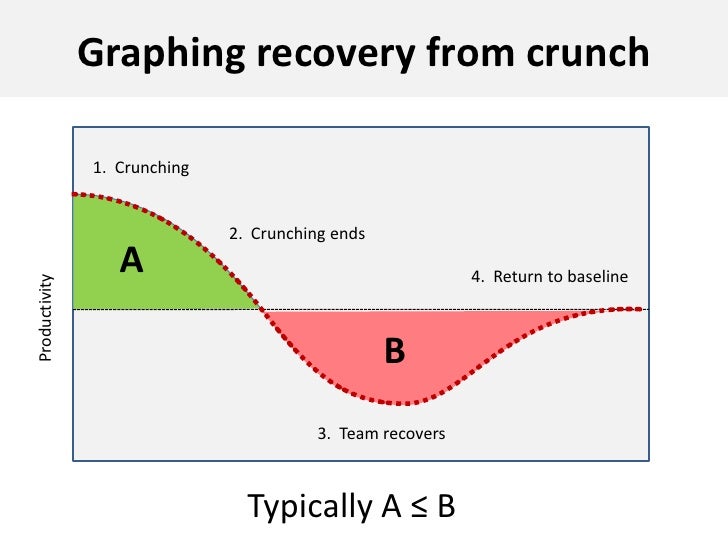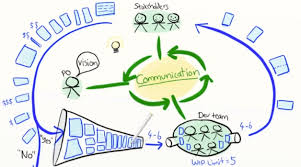It may sound overly simplistic but in my experience products generally succeed or fail in correlation to the effectiveness of Product Ownership on the team. Mainly because we under-appreciate the importance and the difficulty of the Product Ownership aspects in the product creation process. In my opinion the choice of this role is far more important than the coach or other team members. The role is full spectrum, they go all the way from discovery to delivery and more.
Ironically, we tend to think of software applications as being primarily technical objectives, our focus is too often on the quality and ability of the engineers, the architecture and design. We will spend time on process and optimization and efficiency. All the while forgetting that the most common and most consistent failure of all software products is that no matter how good the quality, how optimized or efficient it is, or how good the engineers are that built it – if you build the wrong thing it is a failure. A perfectly designed but unused product is worthless.
History if full of great products that missed the mark, how many apps have you downloaded to your phone that are no longer used or were never used after the first 30 seconds. There are many many more products that fail to ever get in the hands of customers at all. Internal IT products are often culprits of this, the assumption seems to be that because the users are forced to use the product we don’t have to actually ask them what they want or how they will use it, we build great products that don’t fulfill the actual user need.

I think probably my favorite and most over used quote is:
There is surely nothing quite so useless as doing with great efficiency what should not be done at all.
Peter Drucker
I use the quote far too frequently but in 25 years developing software this remains the most frequent sight I see, more products fail for not meeting the most basic customer needs than for any other reason. And yet when I say this, it generally gets scoffed at, until you start asking how many people have worked on products that have been abandoned or shelved mid development. Teams rarely believe their product is at risk of being cancelled, or are too far removed from the customer to appreciate that the user liking and using the product is infinitely more important than whether they are efficiently re-using a section of code. We have created a mindset that ‘done’ is delivering code. A product/feature/story is only really done when the customer is using it.
Product Ownership does not need to be a single person in that role, but it should be a mindset within the team. Ideally I’d love for this to be a shared responsibility. Unfortunately in my experience a true appreciation of Product Ownership is as scarce as Hen’s Teeth, and generally unappreciated and vastly underpaid, those that do it well make it look easy and doing it badly or being indecisive can really destroy a product so it can be a risk to spread the responsibility beyond one person. I have heard people talk of teams where the teams do it well and they don’t need a PO, but I have yet to see this for myself. Because of this experience I think of the Product Owner as the most important ‘hire’ for the team, getting the right person in this role can be crucial to the success of the product.
A good PO these days is hard to find…
So why is a good Product Owner so hard to find and what makes the role so difficult?
1: Differentiating what is needed from what is wanted
A significant part of the role is identifying what is needed to solve your users problems or to fulfill their needs, to enable them to be better at their job, or to maximize their fun or relaxation. The role is about understanding the problem and creating a vision of how that could be solved – not the technical solution but discerning the true need or true problem.

If I had asked people what they wanted, they would have said faster horses.
Henry Ford
The reason this skill is so tough is that users rarely know what they need, typically a user’s vision is constrained by what they currently do. As a result many products become re-works of a paper system or re-engineering an old system. A poor product owner gives a customer what they want or what they ask for, a good product owner listens and watches and blends wants and needs to solve the customer’s problem and give them what they need.

I often seen backlogs that are full of stories that are unfiltered customer requests, it is lazy and it is easier to do what is asked. But to find what is needed typically requires experimentation, feedback, conversations and observation. It is far harder to build what is needed than it is to build what is asked for. Similarly this can manifest itself when department managers decide what their team needs or wants without involving them in the discussion, a good Product Owner will spend time with the users of the product and ideally see how they use it.
A Product Owner with the creativity, the initiative and the Vision to create a great Product is worth their weight in gold,
2: Understanding what is required to create a successful application
A second aspect of the role is the one I see most frequently overlooked. Perhaps because of the emphasis on 1, the need to understand the business, I see people choosing someone from the business to become the Product Owner, their knowledge of the business is seen as their primary qualification and in many cases their only qualification for the role. And worse they are often asked to do the role in addition to their normal job.
However, a great Product Owner understands not only what to build but is familiar with the development process, they understand the ebbs and flows, they understand the implications of technical debt, automation and testing. The understand how crucial it is to have working software in the hands of users as soon as possible. I am sorry to say that business POs often lack this knowledge and experience, they will mistakenly perceive a desire for a fully working product rather than appreciate the value of early feedback. Many are plagued with the last bus syndrome, trying to include every imaginable feature rather than working towards a minimum feature set to get feedback and derive value early.

Personally I’d invariably trade an experienced Product Owner with zero business knowledge for an expert in the business with zero software delivery experience. Business knowledge can be gleaned from effective conversation, observation and feedback. The understanding of a good Agile Software Development lifecycle is far harder to learn and there is no substitute for experience.
Typically the best products result from experiments, reviews and feedback, a willingness to be flexible and respond. The other disagreeable quality of a Product Owner taken from the business is that their knowledge is about how the work is done now, and they are often blinkered to the possibilities.
Remember that the Product Owner sets priorities and interprets the Vision, they have more influence on the product creation than anyone. Their choice of priorities can profoundly impact the value, and the quality of the product. If they lack the understanding of the importance of testing, feedback and good software principles it can lead to conflict and disharmony in a team.
3: Communicating effectively with both technical and business stakeholders
Finally there is a need for effective communication. We always talk about effective communication to the point that it becomes background noise. But the importance cannot be overstated.
A great Product Owner, listens, they observe, they probe and they reflect. The ask for feedback and they read between the lines, they watch body language, they see and hear what isn’t said as much as what is said. When it comes to understanding the user they have great attention to detail and they look intently for pain points and points of pleasure, they are looking for a way to serve their users in the best way they can. Most of us think of communication as speaking, but for a Product Owner watching and listening are so very important. Empathy with the user, the customer and the ability to communicate using their terms and understanding their domain and conversing with them in a meaningful way is crucial, and if you don’t understand the terms develop an attitude of attentive student ask questions and show you are interested and are learning.
A great Product Owner learns to say ‘No’ powerfully respectfully and does so in a way that conveys they understanding to the person asking, a great Product Owner should not be seen as an obstacle or a hurdle but a steward of good decisions. The word ‘No’ should be delivered in a way that leaves me feeling confident that the Product Owner will deliver the best product within the parameters and leaving me confident that this decision is right even if it is not what I initially wanted. The Product Owner should be able to convey the implications of saying ‘Yes’ so that I understand why I am being told No. A great Product Owner has any number of tools that can help people see this and yet we regularly see backlogs full of feature requests that will never see the light of day because the PO doesn’t feel capable or sufficiently empowered to say NO!

But the PO must also communicate with the development team, they must understand technical development terms, to have a grasp of the technical implementation, even if they do not have authority over the ‘How’ I’d expect them to have a vested interest in understanding it. They also need to be able to communicate the business needs and the business terms in a meaningful way to the development team, This requires a versatility in speech and communication that is unusual to say the least. Being respected and understood by both the business and the technical team is a major feat, and as we all know any cloistered group speaks in three letter acronyms that only they understand and the audible sign when they have to explain to an unlearned outsider can demoralize the best of us. Do not underestimate this ability.
But there is more, they need the creativity to communicate design ideas or if the ideas come from others the scope to understand that creativity, to imagine what could be and express that to the business and to the technical team. And then we get into the really tricky realm of the stakeholders as opposed to the users, this generally is the group that funds the product, they want to see progress, they want to see good stewardship of their investment, they may ask for forecasts and may even press for commitments.
We have now loaded our Product Owner with the need to communicate with senior people that make financial decisions, to express Risk and Forecasts in a manner that it concise but meaningful, we want to be transparent and informative, but confident. If we are using forecasts especially mathematical forecasts we had better understand them and be able to back them up with explanation and confidence. A Product Owner my stand their ground in the face of authority and speak truth to power. A Product Owner that makes unrealistic commitments or promises, will lose the confidence of her team and her stakeholders in a flash.
If a Product is to be sold it is likely that you will need to be involved in Sales and Marketing, which brings a whole host of other skills and communication issues to bear, understanding the implication to the market, and how you measure that and how you engage with that is a new realm of understanding and confusion.
A great Product Owner is a master communicator, they have an insatiable desire for knowledge, to understand and be understood.
Summary
As you can see the skill set of a great Product Owner is monumental, and yet the good ones make it look easy. If you have a mindset suited to Product Ownership it is likely you already have good communication skills and enjoy learning more domains.
It is likely you are the sort of person that thrives on the delivery of a product and revels in the feedback, enjoying the flexibility and change, is unmoved at the thought of redoing something twice or even more to get it right.
Solving problem is a thrill and being able to see beyond the obvious and draw out information from users and then present something back is a joy.
That doesn’t mean it isn’t incredibly difficult, overwhelming at times and sadly unappreciated, and very often underpaid.
At some point the industry dismissed all these skills as unimportant and we see a flurry of Product Owners that write stories exactly as dictated by users, that input data into forecasting tools without the vaguest notion of what the forecasts mean or how they are calculated.
As I said at the start a great Product Owner is the lynchpin of a great Product, we should be seeking them out and rewarding them appropriately, you will be amazed at what can be achieved with the right person in that role.






























